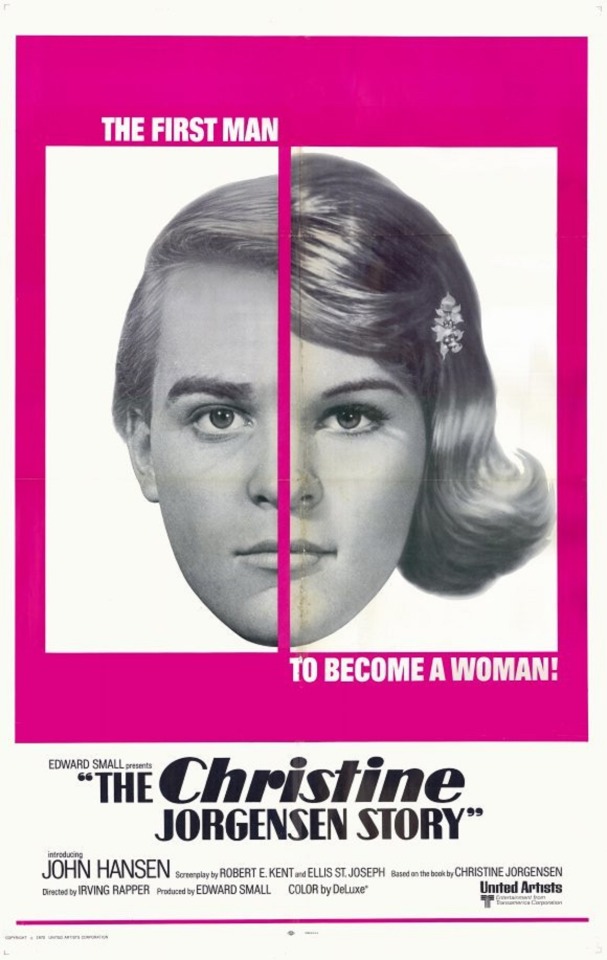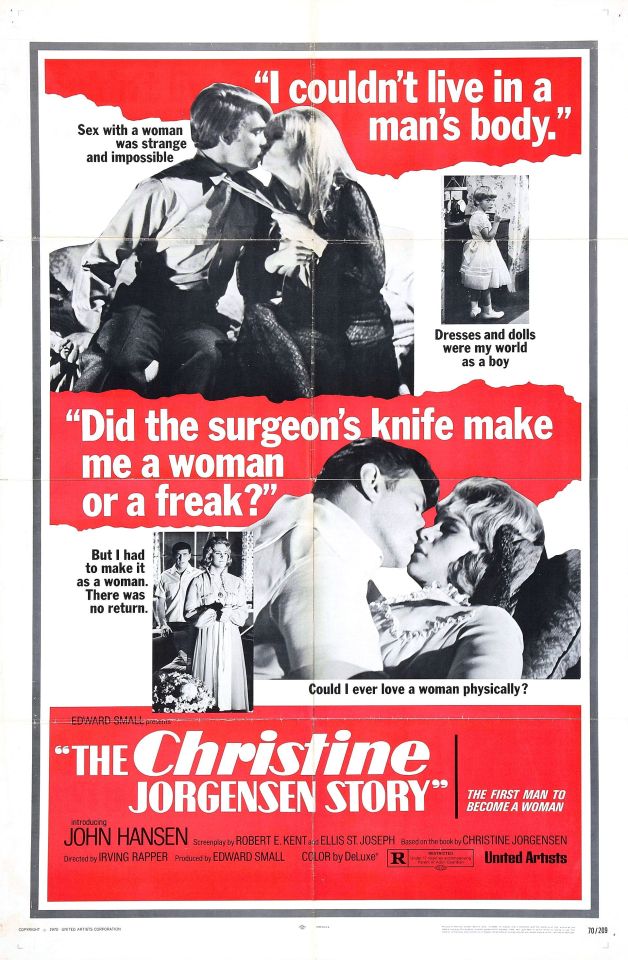#the christine jorgensen story
Text





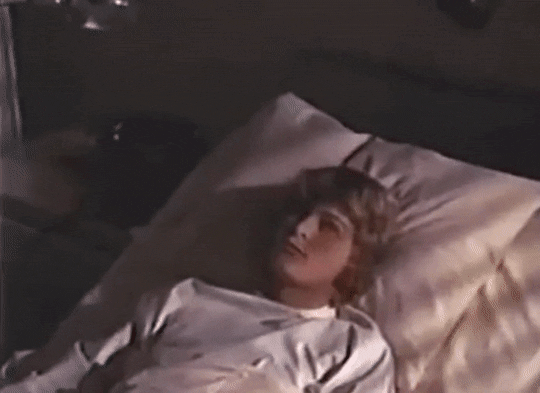




THE CHRISTINE JORGENSEN STORY (1970)
dir. Irving Rapper
Half fiction, half truth, and based on her own autobiography, this is the life story of Christine Jorgensen, known as the first trans woman in the US to have a sex-affirming operation. Ever since she was a young child, Christine felt she was different from the boys, and by the time she becomes an adult, she finds herself increasingly confused regarding her identity. After a lot of research, Jorgensen heads to Denmark to have genital reconstructive surgery performed under the auspices of Dr. Victor Dahlman.
(link in title)
#lgbt cinema#trans cinema#the christine jorgensen story#christine jorgensen#us cinema#lgbt#trans#transgender#usa#lgbt movie#trans movies#us movie#lgbt film#trans film#us film#lgbt media#trans media#queer cinema#north american cinema#irving rapper#Joan Tompkins#Quinn K. Redeker#1970#1970s#70s#70s movies#70s cinema#70s film#1970s movies#1970s films
23 notes
·
View notes
Text
On January 31, 1998 The Exorcist, The Hand, and The Christine Jorgenson Story were screened on MonsterVision.




Here's some art inspired by all three features!
#monstervision#tnt's monstervision#the exorcist#the hand#the christine jorgensen story#horror art#horror film#lgbtq cinema#irving rapper#william friendkin#oliver stone#cult classic#cult movies#cult film#movie fan art#new art#movie art#art#drawing#movie history#pop art#modern art#pop surrealism#portrait
4 notes
·
View notes
Text
youtube
Cinco curiosidades que aconteceram no mundo do cinema em 1970 e que você provavelmente não sabia!
#1970#70's movies#airport#airport movie#burt lancaster#catch 22#imax#christine jorgensen#love story#ryan o neal#ali macgraw#paramount pictures#the christine jorgensen story#Youtube
1 note
·
View note
Text

I debated with myself whether or not to include Christine Jorgensen in my history of drag because technically, she was never a drag queen. She was never impersonating a woman, she was simply being a woman. However, her story was such a milestone and she was such an icon that it feels wrong not to include her.
Christine Jorgensen was the first American trans woman to undergo gender-reassignment surgery. Because her parents were immigrants from Denmark, she was able to travel there and stay through 1951 and 1952 while undergoing hormone therapy and then through several surgeries.
Christine was forcibly outed when a letter to her parents explaining her transition was leaked to The New York Daily News.
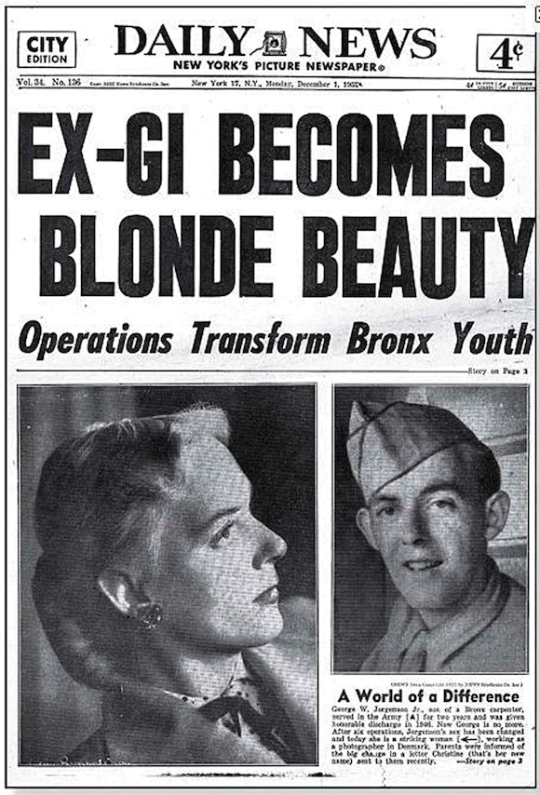
While she had intended to live a quiet, private life, Christine was gracious and humble when her return to the US was swarmed with photographers and reporters.
youtube
Even though she had never intended to cause such a storm of publicity, she never shied away from it. She used her platform to become a tireless defender of transgender rights, and was able to build her way into a successful career as an entertainer.

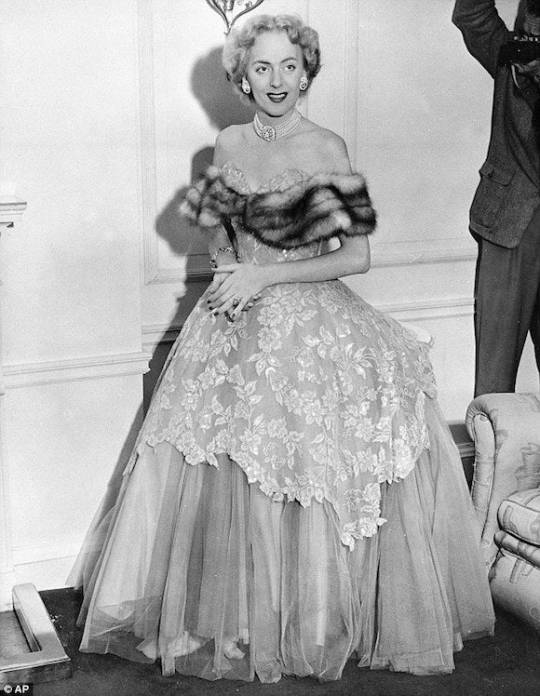
Even when faced with the most vile and violent transphobia, Christine was always poised, elegant, and quick-witted. Her style, charm and good humor endeared her to millions of fans. Her icon status is well-deserved.


#history of drag#drag#trans#transgender#trans history#transgender history#gay#queer#gay history#queer history#lgbt history#lgbt#Youtube
380 notes
·
View notes
Text
Stumbling across that weird fanatically anti-transmasc cult again and this tweet really sums it up better than anything

Trans women are defined entirely by misery and tragedy. Historical trans women all died in asylums. That's why Christine Jorgensen, the first trans woman to get gender-affirming surgery in the US, tragically *squints* spent decades as a in-demand public speaker and headlining entertainer. Because trans women literally can't experience anything other than misery
I have a book from the 70s with an ad for a speaker's agency that lists her alongside Rod Serling and Cicely Tyson. And underneath Erich von Daniken, which is irrelevant to my point but really weird. She was not wasting away in an asylum. Many trans women led tragic lives; but many is not all, and there are historic examples, even really famous ones, of trans women who were happy
Why would they erase that to tell people trans women all suffer tragic fates and must suspect everyone oh yeah bc they're a cult preying on the vulnerable and trying to convince them they need protection (but oddly enough from other trans people more than anyone else?)
The trans man thing is a reference to Victor Barker, who was, indeed, a trans man and a fascist in the 1920s. But I think another key point is, uh, that was one fuckin' guy. Why are they tacking that on, except if they're trying to imply trans men are secretly fascists? But that'd be an absurd thing to belieTHEY BELIEVE THAT. That is a real thing these creeps believe now and are seriously implying on the reg
"You must be suspicious that trans men are fascists" is now part of their ever-evolving litany of apparently endless evil from transmascs who...called a internet famous trans woman an asshole? Made a bad tweet once? Literally anything a trans man ever does (or doesn't do) transforms into a collective action on the part of all trans men in their minds. Trans men aren't just not allies in their mind, but are comically evil Saturday morning cartoon villains
Also, of course, the insistence that trans men had it much easier than trans women. If all trans women's lives weren't misery, all trans men's lives weren't happy, either. This insistence they had it "easy" is giving James Somerton on Radclyffe Hall
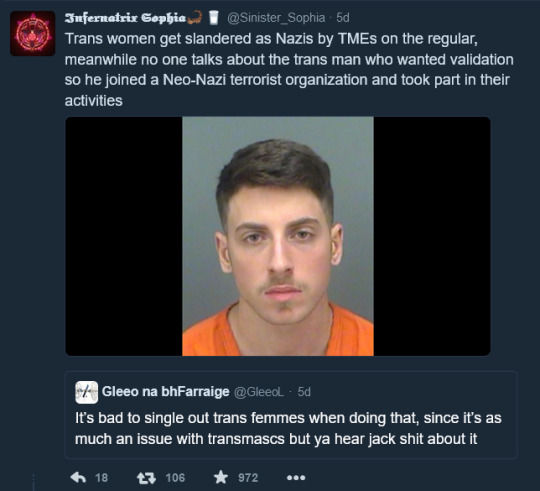
This is, again, A Single Guy. You have proved two white trans men are fascists, one in the 1920s and one now. Maybe. Maybe some other factor is at play, some other identity shared, by these two men, and the majority of fascists. "Why do people think I hate trans men?" says a group with a list of trans men they hate they can trot out instantly
I think people are just primed to think evidence of one member of a marginalized group doing a shitty thing is proof they all do it, or to go "that's just one guy?". In another life this jabroni wouldn't be posting about how Mao would be a Baeddel (???), they'd be sharing Fox News stories about crimes to declare we need to deport all Muslims and Mexicans. It's the same psychology, just rotted by internet discourse instead of a more traditional reactionary ideology
Also you may wonder "wait, I'm a trans woman, and trans men calling me a Nazi happens quite rarely, actually". I'm a trans woman on the internet and trans men calling me a Nazi has happened a grand zero times. So you may then wonder why, precisely, this sweet, innocent bean who's never done anything wrong is called a Nazi so regularly they think it's a universal problem.
Anyway they tweeted out the Fourteen Words, but they said gay women instead of white children. Truly, how could anyone ever get the idea they're a Nazi
167 notes
·
View notes
Text

Found this mixed review of The Christine Jorgensen Story from 1970 in the Smithsonian Archives. I couldn't not share Christine looking so happy under the title "Castration for fun and profit." Same, Christine. Same.
158 notes
·
View notes
Text
Black on Both Sides: A Racial History of Trans Identity by C. Riley Snorton

The story of Christine Jorgensen, America’s first prominent transsexual, famously narrated trans embodiment in the postwar era. Her celebrity, however, has obscured other mid-century trans narratives—ones lived by African Americans such as Lucy Hicks Anderson and James McHarris. Their erasure from trans history masks the profound ways race has figured prominently in the construction and representation of transgender subjects. In Black on Both Sides, C. Riley Snorton identifies multiple intersections between blackness and transness from the mid-nineteenth century to present-day anti-black and anti-trans legislation and violence.
Drawing on a deep and varied archive of materials—early sexological texts, fugitive slave narratives, Afro-modernist literature, sensationalist journalism, Hollywood films—Snorton attends to how slavery and the production of racialized gender provided the foundations for an understanding of gender as mutable. In tracing the twinned genealogies of blackness and transness, Snorton follows multiple trajectories, from the medical experiments conducted on enslaved black women by J. Marion Sims, the “father of American gynecology,” to the negation of blackness that makes transnormativity possible.
Revealing instances of personal sovereignty among blacks living in the antebellum North that were mapped in terms of “cross dressing” and canonical black literary works that express black men’s access to the “female within,” Black on Both Sides concludes with a reading of the fate of Phillip DeVine, who was murdered alongside Brandon Teena in 1993, a fact omitted from the film Boys Don’t Cry out of narrative convenience. Reconstructing these theoretical and historical trajectories furthers our imaginative capacities to conceive more livable black and trans worlds.
#black on both sides#black on both sides: a racial history of trans identity#c. riley snorton#transfem#transmasc#trans book of the day#trans books#queer books#bookblr#booklr
74 notes
·
View notes
Text
Black on Both Sides: A Racial History of Trans Identity by C. Riley Snorton
goodreads

The story of Christine Jorgensen, America’s first prominent transsexual, famously narrated trans embodiment in the postwar era. Her celebrity, however, has obscured other mid-century trans narratives—ones lived by African Americans such as Lucy Hicks Anderson and James McHarris. Their erasure from trans history masks the profound ways race has figured prominently in the construction and representation of transgender subjects. In Black on Both Sides, C. Riley Snorton identifies multiple intersections between blackness and transness from the mid-nineteenth century to present-day anti-black and anti-trans legislation and violence.
Drawing on a deep and varied archive of materials—early sexological texts, fugitive slave narratives, Afro-modernist literature, sensationalist journalism, Hollywood films—Snorton attends to how slavery and the production of racialized gender provided the foundations for an understanding of gender as mutable. In tracing the twinned genealogies of blackness and transness, Snorton follows multiple trajectories, from the medical experiments conducted on enslaved black women by J. Marion Sims, the “father of American gynecology,” to the negation of blackness that makes transnormativity possible.
Revealing instances of personal sovereignty among blacks living in the antebellum North that were mapped in terms of “cross dressing” and canonical black literary works that express black men’s access to the “female within,” Black on Both Sides concludes with a reading of the fate of Phillip DeVine, who was murdered alongside Brandon Teena in 1993, a fact omitted from the film Boys Don��t Cry out of narrative convenience. Reconstructing these theoretical and historical trajectories furthers our imaginative capacities to conceive more livable black and trans worlds.
Mod opinion: I haven't read this book yet, but it sounds very interesting and is on my tbr.
#black on both sides#black on both sides a racial history of trans identity#c. riley snorton#polls#trans lit#trans literature#trans books#lgbt lit#lgbt literature#lgbt books#nonfiction#history#trans studies#to read
18 notes
·
View notes
Text
Transfem authors of fiction: a list
I wrote a version of this list in Swedish for a meatspace friend, figure I might redo it for a tumblr audience. The books recommended are usually novels, and in case of prolific authors, the one recommended is usually the most successful and acclaimed one. I haven't read all of these, but I'm working on it. The list is in alphabetical order after the author's last name. I added some notes to the list, to introduce the authors and their books.
Nota Bene this list is based on my personal research, and largely reflects my own tastes in fiction, as in what I've read and considered reading. And it is of course not at all complete. And it's a transfem authors list, so no transmasc authors no matter how worthy. And it's about authors of fiction, not memoirs or non-fiction. So no Christine Jorgensen, even if she wrote a book I want to read. And Jan Morris gets in based on her two Hav novels, not her more prolific non-fiction work. Links are to my reviews on this blog if they exist.
Anders, Charlie Jane - SF/F writer, debuted with Choir Boy (2005), but most famous for All The Birds in the Sky (which won a Nebula).
Aoki, Ryka - her latest sf/f novel Light from Uncommon Stars is her most popular, but she has published both fiction and poetry before.
Becker, Saga - Våra Tungor Smakar våld (Swedish author, her book is untranslated, although quite good)
Binnie, Imogen - Nevada
Daniels, April - Dreadnought and its sequel Sovereign. Novels about a teenage trans girl superhero.
Deane, Maya - Wrath Goddess Sing
Felker-Martin, Gretchen - Manhunt (horror novel)
Kaveney, Roz - Tiny Pieces of Skull (also wrote the Rhapsody of Blood fantasy series, plus numerous poetry collections and non-fiction)
Kiernan, Caitlin R. - Usually categorized as a horror author, written numerous novels and short stories since her debut novel SIlk in 1998. The most acclaimed are probably her novels The Red Tree and The Drowning Girl (which won the Bram Stoker Award)
Leitz, May - Fluids and Girlflesh (review forthcoming)
Morris, Jan - Hav (mostly wrote non-fiction, history books and travel literature, Hav is an omnibus of her two novels about Hav, both "imagined travelogues" about a fictitious country)
Peters, Torrey - Detransition Baby
Plett, Casey - Little Fish (Lambda award winner)
Pollack, Rachel - Prolific writer of several kinds of books, including a pioneering career as a sf/f writer. Did her fictional debut with a short story in a 1971 anthology (credited under her deadname) and published her first novel Golden Vanity in 1980, which are literally the earliest pieces of fiction by an out trans person (not memoir or non-ficton) I've been able to find. So very much a pioneer. Her most acclaimed book is probably Godmother Night (1996) which won the World Fantasy Award. Also wrote comics, most notably Doom Patrol.
Rumfitt, Alison - Tell me I'm Worthless
Serano, Julia - 99 Erics (her debut as a novelist after years of pioneering transfeminist writing and poetry)
Thornton, Jeanne - Summer Fun (Lambda award winner)
76 notes
·
View notes
Text
Trust in Trans Becomings
This post is written by Vasudha (they/them), a Brackenridge Fellow in the David C. Frederick Honors College and a fourth year undergraduate student majoring in Natural Sciences and Gender, Sexuality, and Women's Studies.
My time with the transgender underground press in the Hillman Archives & Special Collections lead me to think about how trans pasts and trans presents are intertwined, especially with trans people being heavily scrutinized in our current political climate. Bans against
gender-inclusive books, drag shows (1), and gender affirming healthcare (2) are being proposed and even passed at state-wide levels in an attempt to eradicate “gender ideology”, at the cost of the
trans community’s safety and well-being. In looking through issues of TV-TS Tapestry, which was later renamed Transgender Tapestry, I found one trans political narrative from the past that is still present today, although in different language.
Detransitioning stories have been used often as
conservative talking points for why gender affirming care
should be limited, framing it as causing irrevocable harm to
those who supposedly hopped on the “trans train” without a
second thought, and ultimately regretted their decision (3). In
a 1988 issue of Tapestry, the term “pseudo-transsexual”
was used to describe people who were convinced they were
trans, but were instead “very confused” and “emotionally
disabled”, in the words of Sister Mary Elizabeth.

(Above) Excerpt from "Sy Rogers and the 700 Club: A Response" by Sr. Mary Elizabeth, n/SSE, The TV-TS Tapestry, Issue 52, pg 46-47, 1988. University of Pittsburgh Library System, Archives & Special Collections.
As a devout Christian nun, the words of Sister Mary may seem like
they come from a place of compassion and concern, seeing as she
places blame on the religious community for condemning
gender-diverse people, turning them away from God (see third
paragraph of the above excerpt). But as a White trans woman, Sister
Mary’s words only serve to cast doubt on the self-knowledge of trans
people of color and other marginalized trans people, whose trans
identity is more likely to be written off as false or self-convinced (4).
This doubt quickly becomes reason to turn them away from
receiving care, giving providers the power to choose who is “really”
trans, and who isn’t.
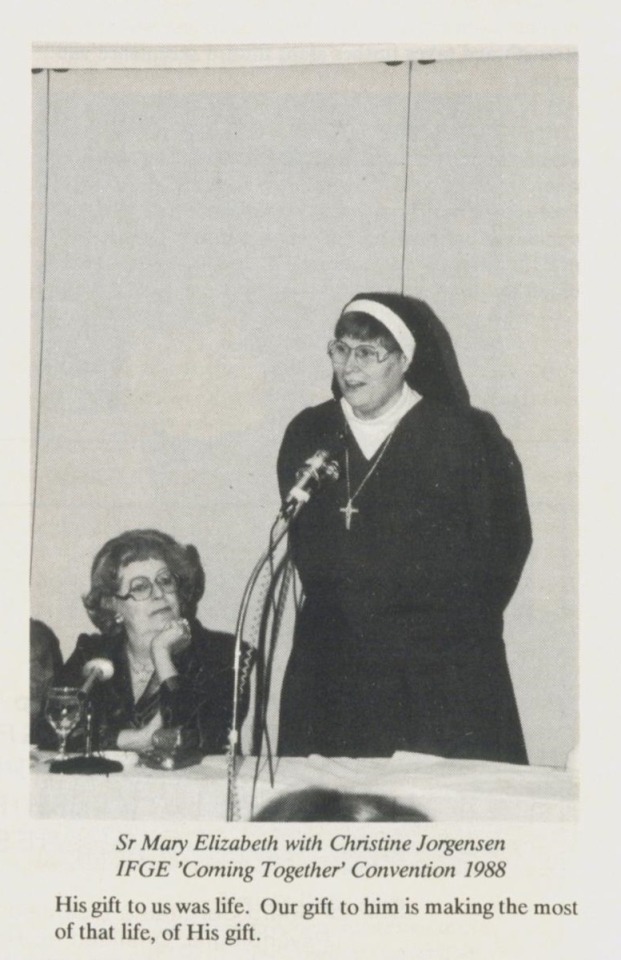
(Above) Image of Sr. Mary Elizabeth with Christine Jorgensen at the International Foundation for Gender Education 'Coming Together' Convention in 1988 from "Sy Rogers and the 700 Club: A Response" by Sr. Mary Elizabeth, n/SSE, The TV-TS Tapestry, Issue 52, pg 46-47, 1988. University of Pittsburgh Library System, Archives & Special Collections.
Today, narratives of detransitioning are covertly doing the same by feigning concern for those who were supposedly coerced into receiving gender affirming care by the “transgender ideology” spread by trans people and enabled by medical caregivers. Politicized detransitioning organizations encourage those who detransition to sue their physicians, effectively scaring well-meaning providers off from treating patients who they deem “emotionally unfit” to transition, and pushing medical practitioners to question the self-knowledge of their patients.
In addition, restricting doubt from trans experiences has related implications. In Transgender Tapestry’s Summer 2005 “Ask Ari” column, a trans woman admits to feeling doubtful about medically transitioning. Ari responds to reassure her that although medical professionals make it difficult to voice these feelings, it is completely normal for trans people to have fears surrounding the process of transitioning.


(Above) "Ask Ari" Column from Transgender Tapestry, Issue 108, pages 18-19, Summer 2005, University of Pittsburgh Library System, Archives & Special Collections.
I resonated with this column as someone who has felt illegitimate for experiencing trans doubt myself, and I realized that we’ve been conditioned to feel that way through medical practices. Throughout the history of trans medical care, diagnostic criteria have included
experiencing mental distress in the form of gender dysphoria (formerly known as gender identity disorder) to be eligible for care. Until last year, the World Professional Association for Transgender Health (WPATH) required a psychologist recommendation and diagnosis for patients to be able to receive care. Although this has been removed from their standards of care, a majority of clinics still use this criteria, which in many cases doesn’t allow for trans doubt to be explored without disqualifying patients from care.
Many trans people do have doubts and fears about medically transitioning, and it’s important that these feelings can be spoken about freely so that patients can be honest about their trans experiences and trust providers with their care. If a patient is forced to exaggerate their need for care in order to be trusted and qualified to receive it, there is no space for real conversations about a patient’s needs and what they hope to achieve through gender affirming
care, which is what may lead to experiences of detransitioning (in the way that conservatives view it) in the first place.
Looking into snippets of trans history provided me with a better sense of trans experiences in today’s world, by being able to see similarities at the core of trans issues throughout time. Trans archival materials serve an important purpose of reminding us that trans
people have always been here, and have been fighting the same anti-trans sentiments for centuries, although they may seem different today. They give us the strength to keep fighting.
Footnotes & Works Cited
Garnand, Ileana. "How drag bans fit into larger attacks on transgender rights." The Center for Public Integrity, April 14, 2023.
HRC Foundation. "Map: Attacks on Gender Affirming Care by State." Human Rights Coalition, Accessed August 8, 2023.
For a better understanding of more common reasons for detransitioning, see this NIH article: Turban, Jack L., et. al., "Factors Leading to "Detransition" Among Transgender and Gender Diverse People in the United States: A Mixed-Methods Analysis." LGBT Health, May/June 2023; 8(4): 273-280. DOI: 10.1089/lgbt.2020.0437. Accessed August 8, 2023.
For a detailed archive-based history on racialized medical gatekeeping of gender affirming care, read Chapter 5 of Jules Gill-Peterson’s Histories of the Transgender Child, titled “Transgendered Boyhood, Race, and Puberty in the 1970s”.
13 notes
·
View notes
Text
On October 29, 1970, The Christine Jorgensen Story debuted in Denmark.


#the christine jorgensen story#irving rapper#john hansen#christine jorgensen#drama film#queer cinema#queer film#lgbtqiia+#biographical film#biopic#grindhouse film#psychotronic film#exploitation film#monstervision#movie art#art#drawing#movie history#pop art#modern art#pop surrealism#cult movies#portrait#cult film
0 notes
Text

This is Christine Jorgensen, a transgender pioneer. The way her story evolved is incredibly sad: an initially curious and enthusiastic public turned to hate — because they would not accept a sterile woman.
Excerpts below from a VICE article by Hugh Ryan
(warning for possible triggers; hate speech after 2nd paragraph):
“Christine's celebrity happened at a very particular time in US history,” said David Serlin, a Professor of Communications and Critical Gender Studies at UC San Diego and the creator of the CJMB. He pointed out, “There was this incredible enthusiasm for science,” and Jorgensen’s transformation was seen as a triumph of modern medicine. The public’s initial response, he said, was, “We are building rockets, we can cure illnesses, and we can take a boy from the Bronx and turn him into a glamorous woman!”
...
This question of realness would end up being Jorgensen’s undoing, Serlin told me. Part of her celebrity had to with America’s love of science, but the rest had to do with how little anyone knew about sex reassignment surgeries. Her peers, even those in the nascent homophile movements of the 50s, had no context for gender transitioning. There was no T in the vague LGB movement, and the word transgender hadn’t even been coined yet. Of course, people with cross-gender desires have always existed, and a few earlier pioneers had also undergone experimental surgical gender reassignments, but they didn’t have a public face in America until Jorgensen, according to GLAAD.
Serlin speculates that at first most Americans “really thought Christine was menstruating and had eggs in her fallopian tubes.” But after six months, the press began to ask more probing questions about what her surgeries actually entailed. When they didn’t like the answers, the country “went ballistic.” Gender panic took over, said Serlin. “They said, ‘He's not a woman. He's just a neutered faggot.’” Reputable magazines like Time stopped using female pronouns for Jorgensen, and coverage of her took on a nasty, speculative air.
America didn’t have a huge problem with someone switching between two discreet and very separate sexes, but the suggestion of some middle ground, of a spectrum between male and female, made people fearful and angry. Jorgensen’s existence and acceptance as a woman implied that gender and the body were not necessarily connected, that gender was something one worked to create. If this were true, the sex-segregated ideals of post-war suburbia would have been out the window. In the eyes of the public, Jorgensen was no longer a man-made woman, but a gender terrorist in a blond bouffant.
...
our awe came first and our hatred came after ... America stumbles towards every new thing like a delighted (but dangerous) toddler, and that our present moment is just another moment waiting to be changed.
#Christine Jorgensen#trans#trans rights#lgbtqplus#womens rights#women#historical#science#scientific literacy#science enthusiasm
61 notes
·
View notes
Text
(This is a really incredible essay by the recently-passed author and trans legend Rachel Pollack, first published in issue #9 of TransSisters: The Journal of Transsexual Feminism. I wanted to reproduce it here in full because it's a goddamn banger, because archived PDFs can be a bit hard to read, and because every trans person should get the opportunity to read it at least once.)
***
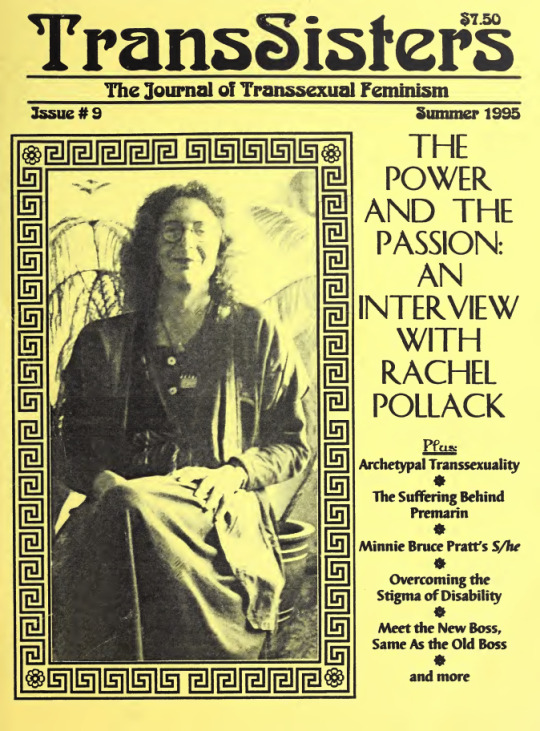
Archetypal Transsexuality
By Rachel Pollack, 1995
The San Rafael Hospital in Trinidad, Colorado has become a kind of shrine for transsexual people in America. Even for those who did not get surgery from Dr. Stanley Biber, his clinic in San Rafael has become synonymous with "sex reassignment surgery" in the same way that the entire nation of Denmark came to symbolize "sex changes" in the 1950s and 1960s, after Christine Jorgensen stepped out of Copenhagen and into the world.
A small hill rises behind the hospital, and on top of it, surrounded by trees and flowers stands a genuine shrine, a small structure dedicated to the Virgin Mary. Behind a conventional statue of Mary, with room for candies and other offerings, the building houses a more precious sculpture of the Christian Goddess. According to the plaque at the front of the shrine, a Trinidad man was caught in a blizzard and in danger of being blown away when be came upon the statue of Mary and clung to it until the fury of nature broke open and he could find his way to help and recovery. The sanctuary he created looks over Dr. Biber's clinic, gently blessing all the trans-formed women and men who pass through its doors.
Now, Mary occupies an interesting place in the history of mythology. Many people know that while the Christian Church attempted to portray God as entirely male, the ordinary people clung to Mother Mary as giver of hope, mercy, and nurturance. Less known is fact that the early Church consciously adapted aspects of various Pagan Goddesses to create Mary's image and place her in the hearts of the people. Two Goddesses in particular contributed to Mary: Aphrodite, who rose from the sea, and Cybele, a Goddess from Asia Minor who earlier had made a triumphant entry into Rome as the Great Mother of the Gods.
I have written elsewhere of Aphrodite as a transsexual Goddess. Her story tells us how the Sky God, Ouranos, was oppressing Gaia, the Earth, until Gaia gave a sickle (a women's harvest tool shaped like the crescent Moon) to her son Kronos. Kronos cut off his father's genitals and threw them into the sea. Ouranos does not die in the story, but withdraws into the shadows, the same way the male persona of many transsexual women will withdraw once the female reality has given itself permission to emerge. The severed genitals, however, do not sink out of sight. Instead. they stir up a great foam on the waters. Out of this foam, golden Aphrodite. the embodiment of femininity in all its grace and power, emerges into the world.
And Cybele -- when the Great Mother came to Rome she brought with her her Gallae. The Gallae were anatomical males who, in the midst of ecstatic group frenzy, used stone sickles to sever their own genitals, which they then flung through open doorways. The families who received the bloody relics considered them a blessing. In return for Cybele's grace, a family would tend to the bleeding Galla and nurse her back to health, at which time she ceremoniously received women's clothing and entered into the service of her Goddess.
The presence of Mary overlooking the San Rafael clinic, and in particular her mysterious emergence out of a storm, forms part of a great web of images and history. The web includes all the mythological figures who change sex or cross genders. It includes the real life Gallae and Hijras and others who alter their bodies as well as the tribal shamans who move into the roles of the "opposite" sex, usually not as a matter of conscious choice, but because the spirits demand it of them. It includes the Stone Age evidence of androgynous Goddesses and cross- sexed priests and priestesses alongside the increasing numbers of contemporary transsexuals who have begun to understand that, as Davina Anne Gabriel puts it, we cannot comprehend transsexuality without some notion of "transcendence," or, as Dallas Denny says, more bluntly, "Transsexuality is a religious experience."
To recognize our place in that web means, paradoxically, to step out of a trap. This is the trap in which we experience transsexuality as a sickness, or even just a psychological condition. For transsexual people, such an ideology (and that is what it is) has become more and more of a dead end - literally, with so many people losing their lives to depression, suicide, bad drugs, unsafe sex and all the other miseries that allow the purveyors of pathology to say "There? You see? If it wasn't a sickness, wouldn't they all be happy?"
Even those of us who insist that transsexual people are not "sick" will still talk about "healing," whether we think we need to heal from shame, or society's oppression, or unhappy childhoods. But as long as we speak of healing we stay within the world of sickness. In the United States we consider happiness the basic human condition, and any suffering as some sort of aberration. I would argue that transsexuality arises from a passion so powerful that it transcends issues of happiness. The word passion originally meant suffering, not pleasure. The suffering of transsexuality, however, is like that of religious ecstasy, or even orgasm -- overwhelming, intense, and ultimately joyous when we surrender to it and let it carry us into the power of the experience.
Think where transsexual desire leads us. We give up our positions in society (I am not talking here about the slide downwards in status for male-to-females, but much more basically of our very places in the world, a loss that applies to transsexual men as well as to women, even if the men eventually go up in status). We risk losing our family and friends. We face ridicule and sometimes extreme violence, even death. We take powerful and dangerous drugs to alter the very shape of our bodies. And finally, we undergo -- we seek out, even demand -- surgery on our genitals. No logical decision, or confusion, or social conditioning, or even mental illness, can account for such an overwhelming need.
Recently, a number of transsexual and transgender people have suggested that people seek surgery because of pressure from the medical profession, which convinces them that surgery will allow them to become normal members of society. I cannot believe this. I have met too many transsexuals who know very clearly that surgery is exactly and precisely what they want, and that the doctors are not their masters but their instruments.
To describe transsexual people as dupes of the medical profession, or slaves to social conditioning, or trapped in rigid ideas about gender roles, is precisely to take away our power, a power so intense that it terrifies people. Sometimes we can see the question in their faces. "What would make someone do -- or want to do -- such a thing?" And because the dual acts of changing gender and altering the body frighten them they try to think of an explanation. "He must hate himself so much." "She can't accept the role society has given her." "Her parents must have abused her." Each of these statements, and all the others, assume that the transsexual man or woman doesn't really know what he or she is doing. And more, they shift the focus from transsexuality itself to some external concept or ideology. All explanations, even friendly ones, drain away the passion of the experience.
It is time to realize that changing gender and altering the body are not the same thing. While many people cannot imagine a gender change without surgery, many others find surgery totally unnecessary. And many people who have surgery will say clearly that it is not the surgeon's knife that makes them men or women, that surgery only changes the outer form to match their inner feelings. The confusion of surgery with gender identity leads many people to think of postoperative transsexual people as superior to preops or to people who change gender without caring about surgery at all. This hierarchy is unfortunate , because it sets people against each other when them is no need for that. At the same time, it also takes away the mystery of surgery itself. Once again, it "explains" surgery as a way just to prove something, or to join an elite. But genital surgery is too strong an experience to dismiss in this way.
Gender identity is a matter of self-knowledge, but also of social functioning. We inhabit our gender and exhibit it to the world. Genital surgery is not really a social experience at all. Obviously, it becomes important in intimate sexual relationships. It may also give us more confidence, as well as legal status. Ultimately, however, surgery is private. It forms a mystery of the body. It may have more in common with religious body altering, such as ritual scarring, than with changing gender. (It is important to remember, however, that transsexual people not only desire surgery but go to great lengths to get it. This makes the experience radically different from any body altering imposed unwillingly on people, such as clitoridectomy performed on pre-adolescent girls, or even the surgery done on intersex babies.)
There is a verse in the Tao Te Ching, the ancient Chinese teaching on "the Way", that speaks directly to some of these issues. In the translation of Gia-fu Feng by Jane English it reads as follows:
"Knowing ignorance is strength.
Ignoring knowledge is sickness.
If one is sick of sickness, then one is not sick.
The sage is not sick because he is sick of sickness.
Therefore he is not sick."
Whenever we try to find the cause of our transsexuality we become weak. This is because we deny its reality within our selves and try to find some explanation outside of us. Some sickness or conditioning. If we know and accept that we are ignorant of what makes us transsexual, and that we should not waste our energy trying to pinpoint some external cause, then "knowing ignorance" will indeed become a source of strength.
But if we cannot know what causes transsexuality, we can know a great deal about it. We can acknowledge its power and its reality, we can learn about other transsexual people and their experiences, and we can discover its ancient worldwide history. To ignore all this knowledge only weakens us and makes us sick.
To overcome the pathology that our culture attaches to transsexuality, we need, above all, to want to overcome it. To finally and utterly reject it. To be sick of sickness. At the moment that we do this, that we become sick of sickness, we begin to escape it, and the deeper we go in that direction, the greater our liberation.
Carl Jung once remarked that the ancients had gods, we have complexes. The Gallae may have experienced feelings and desires similar to those of modem transsexual women. After all, since no one chose them to be Gallae, they must have felt the same overwhelming push to present themselves. But instead of seeing themselves as compelled by a sickness, they believed their Goddess had called them into Her service. Both viewpoints require a surrender, but when we surrender to a Goddess we join ourselves to her power and her beauty. When we surrender to a sickness we get nothing but shame.
Here are two more aspects of that web of images. In Greece, the main God who ruled over transgendered activities was Dionysus. His male followers would dress as women, his female followers would strap on large phalluses. He himself was depicted as a stick with a dress and a beard. Some of the more patriarchal Greek writers described him as "effeminate" or "womanly." Indeed, his myth tells us that he was raised as a girl, and even when he came into his Godhood he often wore feminine clothes and kept his hair long and flowing, something only women were supposed to do.
The psychologist Ginette Paris tells us an interesting story about Dionysus. Raised as a girl, he went mad in adolescence. Paris tells us that we do not know the cause of his madness. Certainly some of the readers of this magazine might make a guess. Insane, Dionysus wanders the world until he comes to Phrygia. the home not only of Cybele and the Gallae, but according to some accounts, Aphrodite. Cybele initiates him, Paris tells us, and restores his sanity. Paris says we do not know how Cybele heals him. Did she initiate him back into his femaleness? Did she lead the God to embrace the doubleness of gender? After he returned from his wanderings, Dionysus became the God of ecstasy, leading men but especially women out of the traps laid for them by a rigid polarized society.
The second myth does not invoke transgendered or transsexual issues quite so directly. However, it involves someone clinging to a statue for deliverance from an emotional storm, and thus it returns us to the presence of Mary overlooking and blessing Dr. Biber's clinic. The Greek Orestes went mad -- madness again -- after Apollo ordered him to kill his mother as punishment for her crime of murdering her husband. Though the Goddess Athena absolved him he still had to pay a penance to the Goddess Artemis (Orestes' mother had killed her husband because he had sacrificed their daughter to Artemis in the hope of gaining the Goddess's favor -- the story of Orestes involves generations of murder and abuse). Thus Orestes wandered the world carrying a statue of Artemis. Finally, he felt the insanity leave him, and he dared to put it down. He set it in a riverbed and walked away. Two Spartans passed by. When they saw the statue staring at them, horribly, from the water, they went mad.
Now, Spartans were known for being ultra-masculine, while Orestes, despite his defense of his father, was considered -- like Dionysus -- effeminate. Thus, the rigidly male Spartans cannot believe the sudden emergence of the dark feminine. But there are more direct connections to our own stories. Artemis was often linked with Cybele. The most famous statue of Artemis stood not in Greece but in Ephesus, a town in Asia Minor, the home territory of Cybele. The Phrygians themselves described Artemis as another name for Cybele.
The Ephesus statue showed the Goddess's torso covered in small globes. Most modern writers assume these are extra breasts, showing her power as the Great Mother. Recently, however, a British archaeologist pointed out that the globes have no nipples. The archaeologist suggested they might have represented the testicles sacrificed by Artemis/Cybele's gallae worshippers.
Classical Greek Artemis was not a mother Goddess but a virgin. We might describe her as forming a link between transsexual women and lesbians (or between the two sides of a transsexual lesbian). Goddess of the Moon, Artemis lived in the mountains apart from the male dominated civilization. She refused all contact with men, spending her time with her band of nymphs. A lover, as well as hunter, of animals, she also watched over women in childbirth. In short, she is almost the model of a back to the land radical lesbian. And yet, as Cybele. she also is the Goddess who accepts the Gallae into her service.
And a final link -- the early Christian council which established Mary as officially the Mother of God took place in Ephesus, the site of that famous statue, once considered one of the seven wonders of the world. And so we come full circle, to Mary, and to Cybele/Artemis, and to statues.
Writing about the story of Orestes, the statue of Artemis, and the two Spartans, Roberto Calasso states: "Such is the power of the image; it heals only those who know what it is. For all others, it is an illness." Transsexuality comes to us with all the power of a divine force who will not be denied. If we recognize it and accept it as a true vision of the self from the deepest part of the psyche, if we carry the Goddess with us until we find ourselves strong enough to set her down, then we may find it opens us to a life of spirituality and joy. If we try to deny it, or belittle it, or explain it away, it can destroy us. Knowing ignorance is strength. Ignoring knowledge is sickness.
If one is sick of sickness, then one is not sick.
***
#WHENEVER WE TRY TO FIND THE CAUSE OF OUR TRANSSEXUALITY WE BECOME WEAK#IF ONE IS SICK OF SICKNESS THEN ONE IS NOT SICK#I'm normally pretty allergic to invocations of spirituality#but this is a perfectly-notched arrow that goes straight through my heart#RIP Rachel Pollack#1945-2023
8 notes
·
View notes
Photo









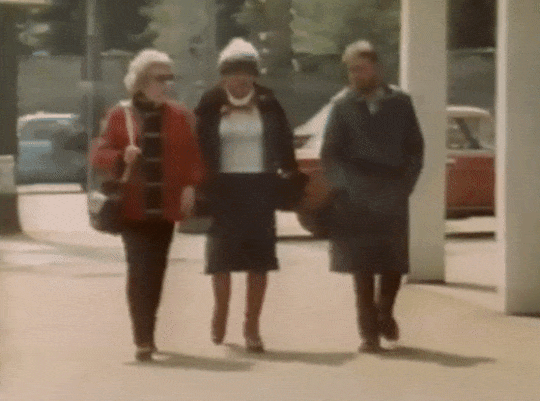
PARADISET ER IKKE TIL SALG (1985)
dir. Teit Ritzau
A portrait of three people who have undergone a gender-affirming surgery : Christine Jorgensen, the American soldier who came to Denmark, underwent an operation and thereby made international headlines; Hanne Rasmussen, a taxi-driver who changes their gender every morning; and Thomas Holck, a bearded, pipe-smoking trans man. Their stories are framed by the historical facts of the persecution of Magnus Hirschfeld in Germany just before the First World War.
(link in title)
#drive link#lgbt cinema#trans cinema#paradise is not for sale#paradiset er ikke til salg#danish cinema#lgbt#trans#transgender#gender-fluid#denmark#documentary#lgbt movie#trans movies#danish movie#lgbt film#trans film#danish film#lgbt media#trans media#queer cinema#christine jorgensen#hanne rasmussen#thomas holck#teit ritzau#80s movies#1980s cinema#1985#1980s#80s film
11 notes
·
View notes
